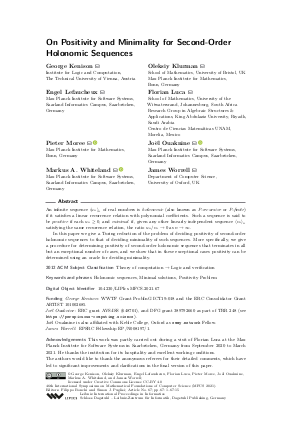@InProceedings{kenison_et_al:LIPIcs.MFCS.2021.67,
author = {Kenison, George and Klurman, Oleksiy and Lefaucheux, Engel and Luca, Florian and Moree, Pieter and Ouaknine, Jo\"{e}l and Whiteland, Markus A. and Worrell, James},
title = {{On Positivity and Minimality for Second-Order Holonomic Sequences}},
booktitle = {46th International Symposium on Mathematical Foundations of Computer Science (MFCS 2021)},
pages = {67:1--67:15},
series = {Leibniz International Proceedings in Informatics (LIPIcs)},
ISBN = {978-3-95977-201-3},
ISSN = {1868-8969},
year = {2021},
volume = {202},
editor = {Bonchi, Filippo and Puglisi, Simon J.},
publisher = {Schloss Dagstuhl -- Leibniz-Zentrum f{\"u}r Informatik},
address = {Dagstuhl, Germany},
URL = {https://drops.dagstuhl.de/entities/document/10.4230/LIPIcs.MFCS.2021.67},
URN = {urn:nbn:de:0030-drops-145071},
doi = {10.4230/LIPIcs.MFCS.2021.67},
annote = {Keywords: Holonomic sequences, Minimal solutions, Positivity Problem}
}

 Creative Commons Attribution 4.0 International license
Creative Commons Attribution 4.0 International license








































